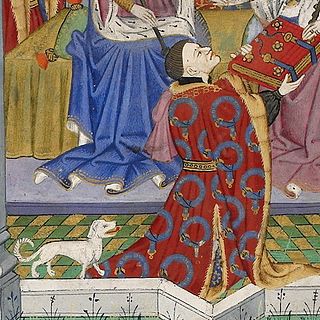Six ships of the Royal Navy have been named HMS Talbot, probably after John Talbot, 1st Earl of Shrewsbury:

The Royal Navy (RN) is the United Kingdom's naval warfare force. Although warships were used by the English kings from the early medieval period, the first major maritime engagements were fought in the Hundred Years War against the Kingdom of France. The modern Royal Navy traces its origins to the early 16th century; the oldest of the UK's armed services, it is known as the Senior Service.

Sir John Talbot, 1st Earl of Shrewsbury, 1st Earl of Waterford, 7th Baron Talbot, KG, known as "Old Talbot", was an English nobleman and a noted military commander during the Hundred Years' War. He was the most renowned in England and most feared in France of the English captains in the last stages of the conflict. Known as a tough, cruel, and quarrelsome man, Talbot distinguished himself militarily in a time of decline for the English. Called the "English Achilles" and the "Terror of the French", he is lavishly praised in the plays of Shakespeare. The manner of his death, leading a charge against artillery, has come to symbolize the passing of the age of chivalry. He also held the subsidiary titles of 10th Baron Strange of Blackmere and 6th Baron Furnivalljure uxoris.
- HMS Talbot (1585) was a ship, listed in 1585.
- HMS Talbot (1691) was a 10-gun ketch launched in 1691 and wrecked in 1694. She had been in French hands between June 1691 and November 1693.
- HMS Talbot (1807) was an 18-gun sloop launched in 1807 and sold into mercantile service in 1815; she then traded between England and India, and made three voyages as a whaler. She was last listed in 1831.
- HMS Talbot (1824) was a 28-gun sixth rate launched in 1824, converted to a powder hulk in 1855 and sold in 1896.
- HMS Talbot (1895) was an Eclipse-class protected cruiser launched in 1895 and sold in 1921.
- HMS Talbot was previously HMS M29, an M29-class monitor launched in 1915. She had been converted into a minelayer in 1919 and renamed HMS Medusa in 1925. She was converted into a depot ship in 1941 and renamed HMS Talbot. She was renamed HMS Medway II in 1943, and Medusa again in 1944. She was sold in 1946 and broken up in 1947.

A ketch is a two-masted sailing craft whose mainmast is taller than the mizzen mast. The name "ketch" is derived from "catch" or fishing boat.
HMS Talbot was a British Royal Navy 18-gun sloop-of-war built by James Heath & Sons, of East Teignmouth, and launched in 1807. Perhaps her greatest accomplishment was the reversal of the liberation of Iceland that the colorful, erratic, former Royal Navy seaman and privateer Jørgen Jørgensen had carried out. Talbot was sold in 1815 for mercantile service. She interspersed several voyages to Ceylon and India with three voyages as a whaler. She was last listed in 1831.

In the 18th century and most of the 19th, a sloop-of-war in the Royal Navy was a warship with a single gun deck that carried up to eighteen guns. The rating system covered all vessels with 20 guns and above; thus, the term sloop-of-war encompassed all the unrated combat vessels, including the very small gun-brigs and cutters. In technical terms, even the more specialised bomb vessels and fireships were classed as sloops-of-war, and in practice these were employed in the sloop role when not carrying out their specialized functions.
HMS Talbot was also the name of the Royal Navy's submarine base at Manoel Island, Malta during the Second World War.

Manoel Island is a small island which forms part of the municipality of Gżira in Marsamxett Harbour, Malta. It is named after the Portuguese Grand Master António Manoel de Vilhena, who built a fort on the island in the 1720s. Previously, the island had been known as l'Isolotto or l'Isola del Vescovo.

Malta, GC, officially known as the Republic of Malta, is a Southern European island country consisting of an archipelago in the Mediterranean Sea. It lies 80 km (50 mi) south of Italy, 284 km (176 mi) east of Tunisia, and 333 km (207 mi) north of Libya. With a population of about 475,000 over an area of 316 km2 (122 sq mi), Malta is the world's tenth smallest and fifth most densely populated country. Its capital is Valletta, which is the smallest national capital in the European Union by area at 0.8 km.2 The official languages are Maltese and English, with Maltese officially recognised as the national language and the only Semitic language in the European Union.
| This article includes a list of ships with the same or similar names. If an internal link for a specific ship led you here, you may wish to change the link to point directly to the intended ship article, if one exists. |
